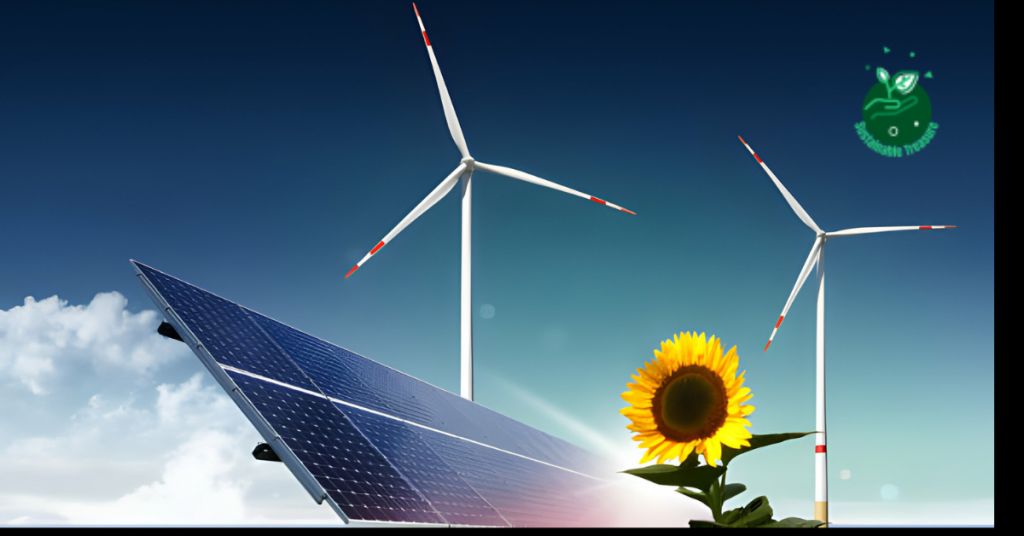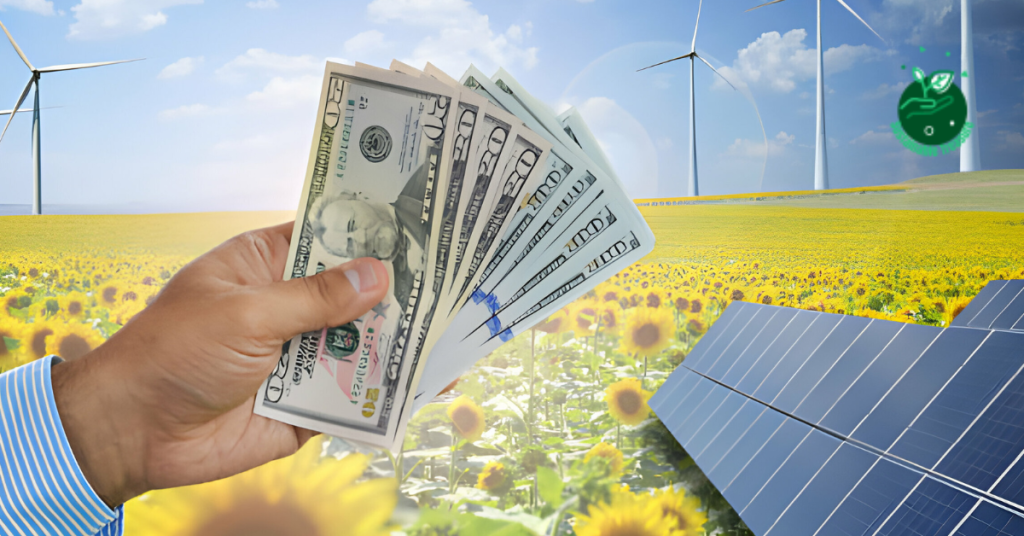Table of Contents
What are two incentives of investing in renewable energy? Two incentives for investing in renewable energy include government incentives such as tax credits, subsidies, etc, and the second incentive is the Long-Term Energy Savings and Resilience.
As the world grapples with the pressing challenges of climate change and dwindling fossil fuel resources, the shift towards renewable energy sources has become an imperative.
While the environmental benefits of clean energy are well-documented, the incentives for investing in this burgeoning industry extend far beyond just ecological considerations.
In this comprehensive blog post, we’ll delve into two compelling incentives that make investing in renewable energy a financially rewarding and forward-thinking endeavor.
What Are Two Incentives Of Investing In Renewable Energy

Here we go:
- Incentive #1: Government Incentives and Tax Credits
- Incentive #2: Long-Term Energy Savings and Resilience
Incentive #1: Government Incentives and Tax Credits
Governments worldwide have recognized the pivotal role renewable energy plays in combating climate change and fostering a sustainable future.
As a result, they have implemented a range of attractive incentives and tax credits to encourage individuals, businesses, and investors to embrace clean energy solutions. These financial incentives not only make renewable energy more accessible but also provide a lucrative opportunity for early adopters and investors.
Tax Credits and Rebates
One of the most substantial incentives offered by governments is the provision of tax credits and rebates for renewable energy installations and investments. These tax benefits can significantly offset the upfront costs associated with solar panels, wind turbines, geothermal systems, and other clean energy technologies.
For instance, in the United States, the federal government offers a Solar Investment Tax Credit (ITC), which allows homeowners and businesses to deduct a percentage of the cost of their solar energy systems from their federal taxes. Similarly, many states offer additional tax credits and rebates, further enhancing the financial appeal of renewable energy investments.
Renewable Energy Certificates (RECs)
Another incentive mechanism that has gained traction is the issuance of Renewable Energy Certificates (RECs). RECs represent the environmental and non-power attributes of one megawatt-hour (MWh) of renewable energy generation.
These certificates can be traded on dedicated markets, allowing renewable energy producers to generate additional revenue streams and investors to capitalize on the growing demand for clean energy.
By investing in renewable energy projects or purchasing RECs, individuals and organizations can support the development of clean energy infrastructure while potentially generating attractive returns on their investments.
| Incentive Type | Description |
|---|---|
| Tax Credits | Deductions from federal or state taxes for renewable energy investments |
| Rebates | Upfront discounts or cash-back offers for installing renewable energy systems |
| Renewable Energy Certificates (RECs) | Tradable certificates representing the environmental benefits of renewable energy generation |
These government incentives and market-based mechanisms not only make renewable energy more affordable but also create a favorable investment climate, attracting capital and fostering innovation in the clean energy sector.
Incentive #2: Long-Term Energy Savings and Resilience
While the financial incentives offered by governments are enticing, the long-term energy savings and resilience associated with renewable energy investments provide another compelling incentive.
By transitioning to clean energy sources, individuals and businesses can insulate themselves from the volatility of fossil fuel prices and reduce their overall energy costs over time.
Energy Cost Savings
Renewable energy sources like solar and wind offer a unique advantage – once the initial investment in the technology is made, the fuel (sunlight and wind) is essentially free.
This means that after recouping the upfront costs, renewable energy systems can generate electricity at a fraction of the cost compared to traditional fossil fuel-based power plants.
As energy prices continue to fluctuate due to geopolitical tensions, supply disruptions, and increasing demand, investing in renewable energy can provide a hedge against rising electricity costs.
By generating their own clean energy, households and businesses can effectively lock in lower, more predictable energy costs for decades to come.
Energy Resilience and Independence
Another significant incentive for investing in renewable energy is the increased energy resilience and independence it offers. By generating their own power on-site or through locally sourced renewable resources, individuals and communities can reduce their reliance on centralized energy grids and fossil fuel imports.
This enhanced energy resilience is particularly valuable in regions prone to natural disasters or power outages, as renewable energy systems can continue to provide electricity even when traditional grid infrastructure is compromised.
Furthermore, by reducing dependence on imported fossil fuels, nations can strengthen their energy security and insulate themselves from geopolitical tensions and supply disruptions.
Here’s a list of potential long-term benefits of investing in renewable energy:
- Stable, predictable energy costs
- Protection against rising electricity prices
- Reduced reliance on fossil fuel imports
- Increased energy resilience and independence
- Reduced vulnerability to power outages and supply disruptions
| Energy Source | Energy Cost Stability | Energy Resilience |
|---|---|---|
| Fossil Fuels | Low | Low |
| Renewable Energy | High | High |
By investing in renewable energy, individuals, businesses, and nations can not only contribute to a more sustainable future but also reap the financial rewards of lower energy costs and enhanced energy security.
FAQs

What Are The Incentives For Switching To Renewable Energy?
The incentives for switching to renewable energy are multifaceted and compelling. Firstly, governments across the globe offer attractive financial incentives, such as tax credits, rebates, and subsidies, to encourage the adoption of clean energy technologies.
These incentives help offset the upfront costs associated with installing renewable energy systems, making them more accessible and financially viable.
Additionally, renewable energy sources like solar and wind provide long-term energy cost savings. Once the initial investment is recovered, these sources essentially provide free fuel, as sunlight and wind are abundant and renewable.
This translates into lower and more stable energy costs over the lifetime of the system, insulating consumers and businesses from the volatility of fossil fuel prices.
Furthermore, investing in renewable energy contributes to energy independence and resilience. By generating power locally from renewable sources, individuals and communities can reduce their reliance on centralized energy grids and fossil fuel imports, enhancing their energy security and reducing vulnerability to supply disruptions.
What Are The 2 Main Types Of Renewable Energy?
The two main types of renewable energy are:
- Solar Energy: This involves harnessing the power of the sun’s rays to generate electricity through photovoltaic (PV) panels or concentrated solar power (CSP) systems. Solar energy is abundant, clean, and widely available, making it a popular choice for residential, commercial, and utility-scale applications.
- Wind Energy: Wind turbines capture the kinetic energy of wind and convert it into electrical power. Wind energy is a rapidly growing sector of renewable energy, with large-scale wind farms and smaller distributed wind turbines becoming increasingly common.
What Are 2 Advantages And 2 Disadvantages Of Renewable Energy?
Advantages of Renewable Energy:
- Sustainable and Renewable: Unlike fossil fuels, renewable energy sources like solar, wind, and hydroelectric power are virtually inexhaustible and can be replenished naturally, ensuring a continuous supply of clean energy.
- Environmental Benefits: Renewable energy technologies produce little to no greenhouse gas emissions or air pollution, thereby reducing the environmental impact and contributing to a cleaner, healthier planet.
Disadvantages of Renewable Energy:
- Intermittency: Some renewable energy sources, such as solar and wind, are intermittent and depend on weather conditions, which can lead to fluctuations in energy production and require backup energy storage solutions.
- High Initial Costs: While the operating costs of renewable energy systems are relatively low, the upfront costs of installation and infrastructure can be substantial, potentially hindering widespread adoption without adequate financial incentives.
What Are The Green Incentives?
Green incentives refer to the various financial and non-financial incentives offered by governments, utilities, and other organizations to promote the adoption of environmentally friendly practices and technologies.
These incentives are designed to make eco-friendly choices more appealing and financially viable. Some common green incentives include:
- Tax Credits and Rebates: Governments often provide tax credits or rebates to individuals and businesses that invest in renewable energy systems, energy-efficient appliances, or electric vehicles.
- Renewable Energy Certificates (RECs): RECs are tradable certificates that represent the environmental benefits of generating one megawatt-hour (MWh) of electricity from renewable sources. They provide an additional revenue stream for renewable energy producers and allow individuals and organizations to support clean energy development.
- Net Metering: Net metering policies enable households and businesses with solar or wind installations to send excess energy back to the grid and receive credits or compensation from their utility providers.
- Green Building Incentives: Many cities and states offer incentives, such as tax credits, fee waivers, or expedited permitting processes, for buildings that meet certain green construction standards or incorporate energy-efficient features.
- Electric Vehicle Incentives: To encourage the adoption of electric vehicles (EVs), governments and automakers often provide purchase rebates, tax credits, or other incentives to make EVs more affordable and accessible.
These green incentives not only promote environmental sustainability but also create economic opportunities and drive innovation in the clean energy and green technology sectors.
What Is The Federal Incentive For Green Energy?

The primary federal incentive for green energy in the United States is the Investment Tax Credit (ITC) for renewable energy systems. The ITC allows individuals and businesses to deduct a percentage of the cost of installing eligible renewable energy systems, such as solar photovoltaic (PV) systems, from their federal income taxes.
Specifically, the current ITC provides a tax credit of 30% for residential and commercial solar PV systems installed before the end of 2032. The credit then steps down to 26% for systems installed in 2033, 22% for 2034, and 10% for systems installed after 2034.
In addition to the ITC, the federal government also offers other incentives and support programs for green energy, including:
- Renewable Energy Production Tax Credit (PTC): This tax credit provides incentives for the production of electricity from renewable sources like wind, geothermal, and certain biomass facilities.
- USDA Rural Energy for America Program (REAP): This program provides grants and loan guarantees to agricultural producers and rural small businesses to assist with the purchase and installation of renewable energy systems and energy efficiency improvements.
- Department of Energy Loan Programs: The Department of Energy offers loan guarantees and other financing support for innovative renewable energy and energy efficiency projects.
- Research and Development Funding: The federal government invests in research and development initiatives to advance clean energy technologies and bring them closer to commercial viability.
These federal incentives, combined with state and local incentives, play a crucial role in promoting the adoption of renewable energy sources and driving the transition towards a more sustainable energy future.
What Does Incentives Mean In Eco?
In the context of environmental sustainability, or “eco,” incentives refer to various mechanisms designed to encourage and motivate individuals, businesses, and organizations to adopt environmentally friendly practices and technologies. These incentives can take various forms, including financial incentives, regulatory incentives, and non-monetary incentives.
Financial incentives are perhaps the most common type of eco-incentives. They involve providing economic benefits or reducing costs associated with eco-friendly behaviors or investments.
Examples include tax credits, rebates, subsidies, and grants for installing renewable energy systems, purchasing energy-efficient appliances, or adopting sustainable practices in businesses.
Regulatory incentives involve creating rules, policies, or standards that promote environmentally responsible actions or discourage unsustainable practices. For instance, governments may implement emissions trading schemes, carbon pricing mechanisms, or mandatory energy efficiency standards to incentivize the reduction of greenhouse gas emissions or the adoption of clean technologies.
Non-monetary incentives encompass a range of non-financial motivators that aim to influence behavior and promote eco-friendly choices. These can include public recognition programs, eco-labeling schemes, educational campaigns, and awareness-raising initiatives that highlight the benefits of sustainable practices and encourage their adoption.
Overall, the concept of incentives in the eco context revolves around creating a favorable environment and providing compelling reasons for individuals, businesses, and societies to embrace sustainability and take actions that contribute to environmental protection and resource conservation.
What Is The Environmental Incentive?
The environmental incentive refers to the motivation or driving force behind taking actions or making decisions that prioritize environmental protection and sustainability.
This incentive stems from the recognition that our planet’s natural resources are finite, and our current patterns of consumption and production are contributing to environmental degradation, climate change, and biodiversity loss.
The environmental incentive can take various forms:
- Ethical and Moral Incentive: Many individuals and organizations are motivated by a sense of moral responsibility to protect the environment and conserve natural resources for future generations. This ethical incentive is rooted in values, beliefs, and a desire to minimize human impact on the planet.
- Economic Incentive: As environmental challenges become more pressing, there is an increasing economic incentive to adopt sustainable practices and invest in eco-friendly technologies. This includes potential cost savings from improved resource efficiency, access to new markets for green products and services, and avoiding potential future costs associated with environmental damages or regulatory penalties.
- Regulatory Incentive: Governments and regulatory bodies may introduce policies, laws, and market-based mechanisms (e.g., carbon pricing, and emission trading schemes) that create incentives for businesses and individuals to reduce their environmental footprint and comply with environmental standards.
- Reputational Incentive: Companies and organizations may be motivated to adopt sustainable practices and demonstrate environmental responsibility to enhance their public image, build brand loyalty, and meet the expectations of environmentally conscious consumers and stakeholders.
- Health and Well-being Incentive: Reducing environmental pollution, preserving natural habitats, and promoting sustainable practices can have positive impacts on human health and well-being, serving as an incentive for individuals and communities to take action.
The environmental incentive is multifaceted and can be driven by a combination of ethical, economic, regulatory, reputational, and health considerations.
Ultimately, it reflects the growing recognition that protecting the environment is not only a moral imperative but also a crucial step towards ensuring long-term economic prosperity and a sustainable future for all.
What Are The Incentives For Green Energy In New York?
New York State offers a range of incentives to promote the adoption of green energy and encourage the transition towards a more sustainable and environmentally friendly energy future. Here are some of the key incentives for green energy in New York:
- NY-Sun Incentive Program: This program provides financial incentives and support for the installation of solar photovoltaic (PV) systems for residential, commercial, and industrial customers. The incentives are designed to help offset the upfront costs of solar installations and make them more accessible.
- Renewable Energy Tax Credits: New York offers several tax credits to incentivize the use of renewable energy sources. These include the Residential Renewable Energy Tax Credit, which provides a credit of up to $5,000 for the installation of solar, wind, and geothermal energy systems in residential properties.
- Net Metering: New York has a robust net metering policy that allows homeowners and businesses with renewable energy systems to receive credits for excess electricity generated and sent back to the grid. This credit can be used to offset future electricity bills, effectively reducing the overall cost of energy.
- Clean Green Residential Building Program: This program provides financial incentives and support for the construction or renovation of energy-efficient and environmentally friendly residential buildings. It encourages the use of sustainable materials, energy-efficient technologies, and renewable energy systems.
- Green Jobs Green New York Program: This initiative provides financing and support for energy efficiency and renewable energy projects in residential and commercial buildings. It aims to create green job opportunities while promoting sustainable energy practices.
- Electric Vehicle Incentives: New York offers various incentives for the purchase and use of electric vehicles (EVs), including rebates, tax credits, and access to high-occupancy vehicle (HOV) lanes. These incentives encourage the adoption of cleaner transportation options and support the development of EV infrastructure.
- Renewable Energy Project Financing: New York provides financing options, such as loans and grants, to support the development and implementation of renewable energy projects, including wind, solar, and biomass initiatives.
These incentives, combined with federal incentives and the state’s commitment to achieving clean energy goals, create a favorable environment for individuals, businesses, and communities to embrace green energy and contribute to a more sustainable future for New York.
Conclusion
As we navigate the challenges of climate change and strive for a more sustainable future, investing in renewable energy presents a compelling opportunity. The combination of government incentives, tax credits, and long-term energy savings not only make clean energy solutions more accessible but also offer attractive financial returns for early adopters and investors.
By embracing renewable energy sources, we can pave the way for a greener, more resilient, and economically vibrant future. Whether you’re a homeowner, business owner, or investor, exploring the incentives and benefits of renewable energy investments is a proactive step towards a cleaner, more sustainable tomorrow.
Image: Credit Istock



